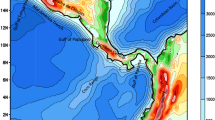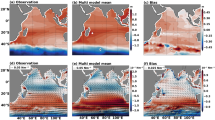Abstract
Eleven climate system models that participate in the Coupled Model Intercomparison Project phase 5 (CMIP5) were evaluated based on an assessment of their simulated meridional transports in comparison with the Sverdrup transports. The analyses show that the simulated North Pacific Ocean circulation is essentially in Sverdrup balance in most of the 11 models while the Argo geostrophic meridional transports indicate significant non-Sverdrup gyre circulation in the tropical North Pacific Ocean. The climate models overestimated the observed tropical and subtropical volume transports significantly. The non-Sverdrup gyre circulation leads to non-Sverdrup heat and salt transports, the absence of which in the CMIP5 simulations suggests deficiencies of the CMIP5 model dynamics in simulating the realistic meridional volume, heat, and salt transports of the ocean.
Similar content being viewed by others
Data Availability Statement
All CMIP5 model simulation data are distributed by the Earth System Grid Federation (ESGF) at the website https://esgf-node.llnl.gov/search/cmip5/. The data are open to public without registration.
References
Arakawa A, Lamb V R. 1977. Computational design of the basic dynamical processes of the UCLA general circulation model. Methods in Computational Physics: Advances in Research and Applications, 17: 173–265, https://doi.org/10.1016/B978-0-12-460817-7.50009-4.
Bretherton C S, Widmann M, Dymnikov V P, Wallace J M, Bladé I. 1999. The effective number of spatial degrees of freedom of a time-varying field. J. Climate, 12 (7): 1990–2009.
Chu P C. 1995. P-vector method for determining absolute velocity from hydrographic data. Mar. Technol. Soc. J., 29(2): 3-14.
Chu P C. 2006. P-Vector Inverse Method. Springer, Berlin. 605p. Gray A R, Riser S C. 2014. A global analysis of Sverdrup balance using absolute geostrophic velocities from Argo. J. Phys. Oceanogr., 44(4): 1213-1229.
Hautala S L, Roemmich D H, Schmilz Jr W J. 1994. Is the North Pacific in Sverdrup balance along 24°N?. J. Geophys. Res., 99(C8): 16041-16052.
Hughes C W, De Cuevas B A. 2001. Why western boundary currents in realistic oceans are inviscid: a link between form stress and bottom pressure torques. J. Phys. Oceanogr., 31(10): 2871–2885.
Kutsuwada K, Kakiuchi A, Sasai Y, Sasaki H, Uehara K, Tajima R. 2019. Wind-driven North Pacific Tropical Gyre using high-resolution simulation outputs. J. Oceanogr., 75: 81–93.
Large W G, Pond S. 1981. Open ocean momentum flux measurements in moderate to strong winds. J. Phys. Oceanogr., 11(3): 324–336.
Leetmaa A, Niiler P, Stommel H. 1977. Does the Sverdrup relation account for the mid-Atlantic circulation?. J. Mar. Res., 35: 1–10.
Lu Y Y, Stammer D. 2004. Vorticity balance in coarseresolution global ocean simulations. J. Phys. Oceanogr., 34(3): 605–622.
Meyers G. 1980. Do Sverdrup transports account for the Pacific North Equatorial Countercurrent?. J. Geophys. Res., 85(C2): 1073–1075.
Roemmich D, Gilson J. 2009. The 2004-2008 mean and annual cycle of temperature, salinity, and steric height in the global ocean from the Argo Program. Prog. Oceanogr., 82(2): 81–100.
Schmitz Jr W J, Thompson J D, Luyten J R. 1992. The Sverdrup circulation for the Atlantic along 24°N. J. Geophys. Res., 97(C5): 7251–7256.
Stocker T F, Qin D, Plattner G K. 2014. Technical summary. In: Climate Change 2013: the Physical Science Basis. Working Group I Contribution to the Fifth Assessment Report of the Intergovernmental Panel on Climate Change. Cambridge University Press, Cambridge, p.33–115, https://doi.org/10.1017/CBO9781107415324.005.
Stommel H, Schott F. 1977. The beta spiral and the determination of the absolute velocity field from hydrographic station data. Deep Sea Res., 24(3): 325–329.
Sverdrup H U. 1947. Wind-driven currents in a Baroclinic ocean; with application to the equatorial currents of the eastern Pacific. Proc. Natl. Acad. Sci. USA, 33(11): 318–326.
Wunsch C, Roemmich D. 1985. Is the north Atlantic in Sverdrup balance?. J. Phys. Oceanogr., 15(12): 1876–1880.
Wunsch C. 1978. The North Atlantic general circulation west of 50°W determined by inverse methods. Rev. Geophys., 16(4): 583–620.
Wunsch C. 2011. The decadal mean ocean circulation and Sverdrup balance. J. Mar. Res., 69(2-3): 417–434.
Yang L N, Yuan D L. 2016. Absolute geostrophic currents in global tropical oceans. Chin. J. Oceanol. Limnol., 34(6): 1383–1393.
Yuan D L, Zhang Z C, Chu P C, Dewar W K. 2014. Geostrophic circulation in the tropical north pacific ocean based on Argo profiles. J. Phys. Oceanogr., 44(2): 558–575.
Zhang Z C, Yuan D L, Chu P C. 2013. Geostrophic meridional transport in tropical northwest Pacific based on Argo profiles. Chin. J. Oceanol. Limnol., 31(3): 656–664.
Zhou H, Liu X Q, Xu P. 2019. Sensitivity of Sverdrup transport to surface wind products over the tropical North Pacific Ocean. Ocean Dyn., 69(5): 529–542.
Zhou H, Yuan D L, Yang L N, Li X, Dewar W. 2018. Decadal variability of the meridional geostrophic transport in the upper tropical North Pacific Ocean. J. Climate, 31(15): 5891–5910.
Acknowledgment
We acknowledge the World Climate Research Programme’s Working Group on Coupled Modelling, which is responsible for CMIP, and we thank the climate modeling groups for producing and making available their model output.
Author information
Authors and Affiliations
Corresponding author
Additional information
Supported by the National Natural Foundation of China (Nos. 41421005, 41720104008, 91858204), the National Basic Research Program of China (973 Program) (No. 2012CB956001), the Qingdao National Laboratory for Marine Science and Technology (No. 2016ASKJ04), the Chinese Academy of Science (No. XDA11010205), and the Shandong Provincial Projects (Nos. 2014GJJS0101, U1406401)
Rights and permissions
About this article
Cite this article
Li, X., Yuan, D. An assessment of the CMIP5 models in simulating the Argo geostrophic meridional transport in the North Pacific Ocean. J. Ocean. Limnol. 38, 1445–1463 (2020). https://doi.org/10.1007/s00343-020-0002-0
Received:
Accepted:
Published:
Issue Date:
DOI: https://doi.org/10.1007/s00343-020-0002-0




